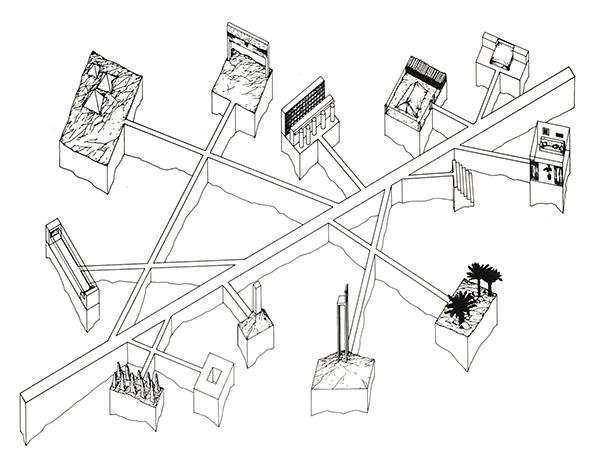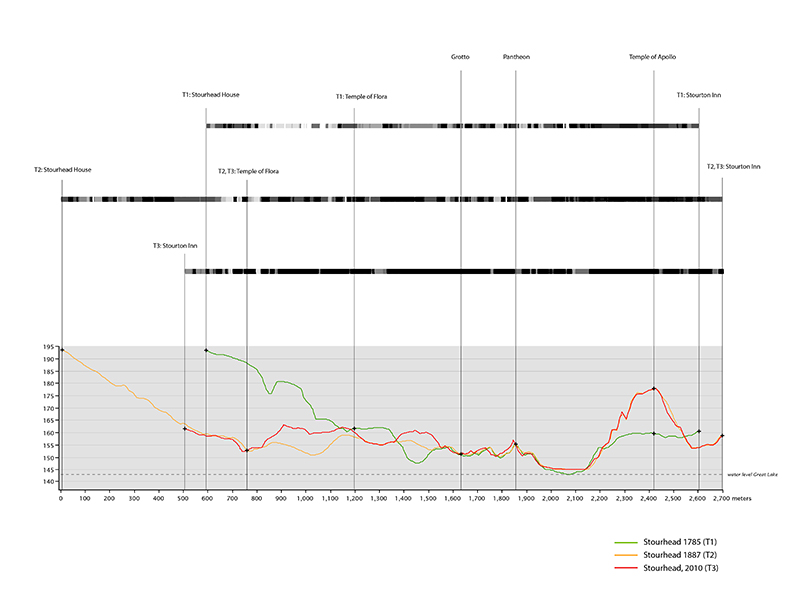Routes are important operative structures in landscape architecture because they play a crucial role in mediating or facilitating the use and reception of (designed) landscapes. Routes are the ‘silent guides of the stroller’ and facilitate the primordial act of walking as an aesthetic and social practice. The shape of a walk refers not only to the formal aspects of routing such as the tracing and gradient of the routes, but also to the landscape space as people perceive it. This perceptual space indicates the visual reality, the sensorial experience that emerges only by bodily movement and is affected by topological, physical, social, and psychological conditions. The psychologist Kurt Lewin proposed in 1934 the term Hodological Space to describe these factual conditions a person is faced with on its way (‘Hodos’, a Greek word meaning ‘way’). The psychogeographical maps of Guy Debord in the 1950’s and Hans Dieter Schaal in the late 1970’s are inspiring attempts to visualize perceptual space.

Mapping hodological space (drawing by Hans Dieter Schaal, 1978)
Visual perception and kinaesthesia
The shape of a walk as a concept connects visual perception to the ‘sense of movement’ or kinaesthesia. In traditional Asian culture it is common to link visual perception with movement as exemplified by the Chinese character for ‘to see’ 見 in which the upper part symbolises the eye 目and the lower part symbolises the feet of a person 儿. Kinaesthetic experience involves several sensory channels for an active participation with the spatial environment. The brain integrates information from proprioception and the vestibular system into its overall sense of body position, movement, and acceleration, which is important for spatial orientation as described by the neuroscientist Alain Berthoz.
Bodily sensation and muscle movement are thus closely related to visual perception. As James Gibson elaborates in his seminal work ‘The ecological approach to visual perception’: “Locomotion is guided by visual perception. Not only does it depend on perception but perception depends on locomotion inasmuch as a moving point of observation is necessary for any adequate acquaintance with the environment. So we must perceive in order to move, but we must also move in order to perceive.” The shape of a walk is therefore determined by a kinaesthetic experience of the designed landscape where visual perception is inherently connected to one’s abilities and possibilities for movement offered by the design.
Bodily sensation and muscle movement are closely related to visual perception (photos by Eadweard Muybridge, 1887)
Walking as field of study in landscape architecture
The shape of the walk is thus of crucial importance in
landscape architecture because it is not possible to perceive space without
movement of the eye, head and body. It determines the tactile and kinaesthetic
experience and is the means to organise the visual logic of a site by directing
the individual’s gaze at views or focal points and their sequence. From this
follows that the shape of a walk is an important unifying and structural
principle in landscape design and the discovery of landscape from past to
present. According to the garden theorist and historian Erik A. de Jong it must
be considered the hinge that steered more than anything else the changing
options for use, experience, and design and contributed fundamentally to both
personal and cultural developments.
From this perspective the shape of a walk becomes a highly relevant field of study in landscape architecture. Not only in the sense that it addresses the phenomenological dimensions of landscape as proposed by the sociologist Lucius Burckhardt with his Science of Strolling (called: Strollology or Promenadology), or that it offers an alternative approach to landscape design that integrates intense space perception, encourages intuition and supports organization as elaborated by landscape architects such as Henrik Schultz and Günther Voght. The shape of a walk is also an important container of design knowledge available for systematic exploration, description and classification. It is an invaluable source of design principles that effectively shape the relation between formal space (‘space of coordinates’) and perceptual space. Studying the shape of a walk can help landscape architects to get a grip on space as perceived from eye-level, kinaesthetic aspects, wayfinding, and the phenomenology of landscape in order to become tools for landscape design.

GIS-based analysis of the shape of the walk at Stourhead Landscape garden combining height gradient, visible features and light and shade along the route (analysis by Steffen Nijhuis, 2015)
Note
The material as discussed above is excerpted from: Nijhuis, S. (2015). GIS-based landscape design research. Stourhead landscape garden as a case study. Delft, A+BE. http://dx.doi.org/10.7480/abe.2015.13
